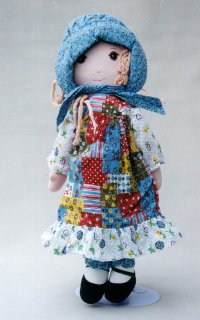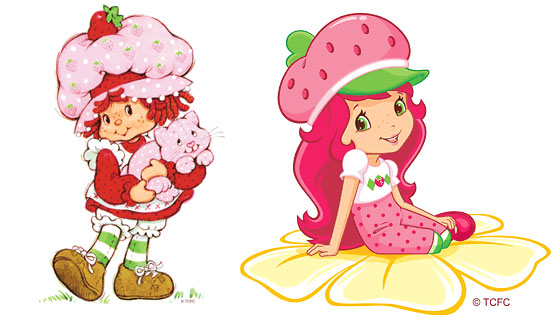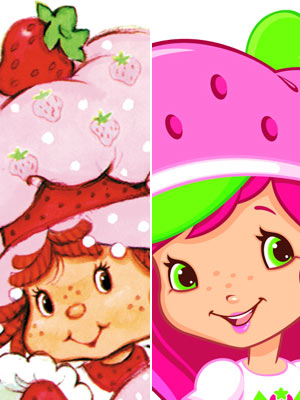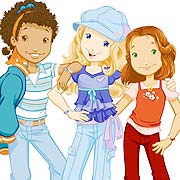One of my former students, Kim D., brought my attention to the old and new versions of Strawberry Shortcake (found here):
Her hair has gotten longer and sexier and she’s more “human” looking. Her clothes are also more form-fitting, and her face is thinner.
Here is a close-up on their faces, from this series of images focusing on her “makeover”:
Notice her lips are fuller and pinker and her eyes are larger. She also has fewer freckles.
The New York Times discussed her makeover:
Strawberry Shortcake was having an identity crisis. The “it” doll and cartoon star of the 1980s was just not connecting with modern girls. Too candy-obsessed. Too ditzy. Too fond of wearing bloomers.So her owner, American Greetings Properties, worked for a year on what it calls a “fruit-forward” makeover. Strawberry Shortcake, part of a line of scented dolls, now prefers fresh fruit to gumdrops, appears to wear just a dab of lipstick (but no rouge), and spends her time chatting on a cellphone instead of brushing her calico cat, Custard.
I don’t remember Strawberry Shortcake being “ditzy,” but maybe my memory is bad. And do kids really like cell phones better than pets these days? They probably do, I’m just out of touch.
Here is the original Holly Hobbie from the 1970s (found here):

The new, sassier version, from USA Today:
There’s a Holly Hobbie website where you can read her journal and watch videos.
When I started looking at these, I was puzzled; if the originals are so unappealing to today’s kids, why are they being re-released? Why not just come up with new products? I found some interesting commentary on Jezebel.com:
As part of a growing toy-industry trend (Care Bears are getting slimmed down; Teenage Mutant Ninja Turtles will be more pumped, less aggro), vintage brands are being reworked to appeal to the kids, while still playing on young parents’ nostalgia…What I find bizarre about all this is the implicit assumption that kids can’t relate to a character who’s not exactly like themselves. Strawberry Shortcake wasn’t popular twenty years ago because we all wore bloomers and lolled around in a berry patch; it was cute and fun and the dolls smelled good. This kind of formulaic thinking presupposes a narcissism that, ironically, agendas like these seem to create.
I think she may be on to something there: the appeal is to parents, not the kids themselves. To a little kid, Strawberry Shortcake and Holly Hobbie have no history and aren’t particularly different from other toys available at the store. It’s their parents who have an attachment to the toys. But since the prevailing wisdom is that kids are more “sophisticated” and grown-up at earlier ages, the toys are tarted up a bit to look more sexified teen or pre-teen girls.
I think these images are good for showing the trend toward making girls’ toys, even those for young girls, increasingly sexy, with an emphasis on more human (as opposed to obviously toy-like) features, make-up, and flirty eyelashes and lips. Don’t get me wrong–I’m not meaning to romanticize the earlier versions as some perfect type of toy for girls or that there’s some idyllic past when childhood was sweet and innocent. Personally, I thought Holly Hobbie was boring when I was a kid, though I adored Strawberry Shortcake (or, more specifically, Blueberry Muffin and Lime Chiffon; all I really cared about was the way they smelled and the pets they came with–I was a farm kid, so animal toys were always of great interest to me). But I do think there’s something disturbing about the ways that so many of the toys we give girls today constantly reinforce the message that sexiness and being flirty are desirable attributes, even for young girls.
That might lead to a larger discussion: why are we seeing this trend? What’s going on there? What might be the cultural impetus behind the choices to design, manufacture, market, and purchase toys that incorporate these messages about femininity?
Thanks, Kim!




Comments 32
73man — June 17, 2008
There's also the change in appearance to reflect a perceived inability of children to see dolls as anything other than human. The new ones seem more lifelike alright and perhaps deliberately so given the perception that childrens' imagination is being 'dumbed down', denuded, denied.
Will — June 17, 2008
I didn't think the new SS is more "human" looking. I see her as more anime looking, which seems to be a huge trend in things aimed at children, even if they don't come from Asia. Another trend I have noticed (primarily on cereal box mascots) is the tendency to redesign characters with less detail and make them look more like computer animations. That's a big change I see above, too... it's as though kids are repelled by hand drawn characters. Personally, I hate it from a design/style perspective, but I can't necessarily say that it is any worse. (OT: I noticed that Pixar seems to be making computer animations look more like hand drawings!)
I think the Holly Hobby example also shows a continuing trend away from things that are (or look) homemode/handmade. Part of growing up in the advertising culture is learning that things that are purchased are inherently "better", and it seems to be getting moreso with each generation.
I agree that making these dolls more sexualized is occurring at the same time that children themselves are being more sexualized.
Jessie Bluejay » Blog Archive » Strawberry Slutcake — June 18, 2008
[...] I suspected, there’s been some concern that Strawberry Shortcake’s new image is “too sexy.” I’m not exactly sure [...]
[xxla] ARE YOU MAN ENOUGH TO ADHERE TO GENDER ROLES!? — November 21, 2008
[...] different from the sexualization of Strawberry Shortcake, as seen and discussed in more detail on Sociological Images. Whereas classic girl things are becoming more “feminine” to fit today’s [...]
Sociological Images » DORA THE EXPLORER’S MAKEOVER: GWEN AND I SAW IT COMIN’ — March 19, 2009
[...] also our post on Strawberry Shortcake’s and Holly Hobbie’s makeover. tags: children/youth, gender, marketing, toys| Permalink| “MEN ARE THE NEW [...]
כך הפכה דורה החוקרת מגיקית לפקאצה : חדר 404 • הבלוג של עידו קינן — March 25, 2009
[...] הפכו לכנופייה לבושת שחורים מפחידה, ובובת הולי הובי הפכה מילדה עם קרזולת אדמונית ושמלת טלאים הומלסית לנערה עם [...]
eyelinerpirate — May 30, 2009
On the subject of sexualized Strawberry Shortcake: American Greetings threatened to sue Penny Arcade six years ago for this parody image.
Penny Arcade's Wikipedia article has a summary of the story.
Alessandra Gilioli — July 12, 2009
I am happy to have stumbled on this dicsussion. I have been following the 'make overs' of SS and Holly Hobbie and have been shocked at the change. What it implies about our current state as a culture. I guess the mere existence of the slutty Bratz wasnt not enough, but to change such a wholesome image as SS... It is scary what do when we dialogue with our children?
Also I have noticed the obvious lack of 'sweet' cartoons. What do have now that is sweet? Dragon Tails, maybe but many others characters even the classics such as Care Bears do have this cold animation style. Just makes me want to turn off the TV more often.
Alexandra — December 16, 2009
A friend of mine and I have been discussing trends like these, and we've decided to start our own line of toys. It will be called Hookerz. The dolls will be almost exactly like Bratz, except they will be explicitly prostitutes with different stories, different pimps, different corners.
Another couple of friends and I have discussed using a different tack: a toy line called My Working Kitty. It will be cats, and they will have different outfits for different professions, e.g. Astronaut Kitty, CPA Kitty, Homemaker Kitty. They will be gender neutral, because it's hard to tell what sex a cat is.
Sadly, of these two fake toy lines, I fear Hookerz would sell better. Even though My Working Kitty would have so many more possibilities.
The New Sun Maid » Sociological Images — December 31, 2009
[...] think–considering also the recent makeovers of Dora the Explorer, Holly Hobbie, and Strawberry Shortcake–we can officially call this a trend. 42 Comments Tags: food/agriculture, gender, [...]
rg — January 2, 2010
zdvzsb
The Evolution of the Dungeons and Dragons Playbook » Sociological Images — January 10, 2010
[...] shower girl, this crazy post on hot horses and puppies, and the makeovers of Dora the Explorer, Holly Hobbie, Strawberry Shortcake, and the Sun [...]
Why Does Growing Up Require Glamour? « Following In My Shoes — May 6, 2010
[...] over at Context Blogs, wrote an interesting article hypothesizing the purpose behind these new, slimmer, less-childlike make-overs. Are the new looks [...]
Anonymous — September 8, 2010
This is sad. I love SS and will be using it as theme for my daughter's 1st bday. Its sad to know what the world is doing.
anna — December 25, 2010
I think those same things myself. I like this article, thank you for posting it.
Bronwyn — February 16, 2011
Ok, so I was never a fan of Strawberry Shortcake, probably because my mom so completely discouraged interest in it. ( I was born in 1973 just for age reference.) I really can't compare the new and the old, Strawberry Shortcake.
All of that said, my girls are watching the new Strawberry Shortcake right now (literally). They love it. I have thus far watched all of the movie and episodes with them. It has good messages. The characters are always sweet, polite, and pretty darn wholesome. My oldest, who will be 5 next week, is one of those naturally skinny kids, with long hair that has literally never been cut, not even a trim. So...yep, she relates to the character, and well...I do too. She wants to wear her hair in a pony tail like Blueberry. That's about all she wants to emulate physically. The characters don't show any sign of breasts. Shoot, we can't even see their ankles. The only skin they show is their faces. I just can't find anything to be distressed about.
I'm just not seeing any negative impact from the modernizing of the character. It's not like Strawberry and her gang are going around announcing their ages..."Hey I'm Strawberry and I'm five years old today." There are no age expectations associated with the character. I am thrilled that they don't really wear makeup. I am thrilled that their hair is long and not some weird ultra modern cut. The have manners! They are polite! They are super thoughtful! My five year old has pickup some extra polite language watching the clothes..."Thank you ...Anytime...Sure Thing!" And made some comments about friends helping each other.
I really feel all the distress in about 'change'. Hasbro is messing with the childhood friend and memories of all our inner little girls. Nope, its not the same, but compared to most of what is out there, its a good clean cartoon with a majority of good messages, social skills, manners, etc.
Shawna — March 6, 2011
I have to say that I was rather impressed with SS's current look. Sure, it's a giant leap from where she was when I was growing up in the 80's, but it's so much better than what is out there right now for girls. She's actually clothed! Compared to Bratz, Barbie, Disney's fairies, and Polly Pockets, I'd much rather that my daughter emulate SS.
mistery — March 7, 2011
i like strawberry shortcake.............................................................................
Beauty and the New LEGO Line for Girls : Ms Magazine Blog — January 10, 2012
[...] here; it is the exact same makeover that we’ve seen in recent years with Dora the Explorer, Strawberry Shortcake and Holly Hobbie, Lisa Frank, Trolls and Cabbage Patch Kids, My Little Pony, Rainbow Brite, and Candy Land (or visit [...]
Beauty and the New Lego Line For Girls « Marketing — April 24, 2012
[...] here; it is the exact same makeover that we’ve seen in recent years with Dora the Explorer, Strawberry Shortcake, Holly Hobbie, Lisa Frank, Trolls, Cabbage Patch Kids, My Little Pony, Rainbow Brite, and Candy Land (or visit [...]
Shakira12345678 — June 9, 2012
hi guys!!! i thought you might need a childs point of view so what a child would say:
i think the changes are ok and the other characters are old and they remind them of what their great or just grandmas would play with when they were younger
Shakira12345678 — June 9, 2012
my last post was meant to have a pic so i will post them now
Disney Characters Put On Starvation Diets; Let's Stop This Trend — August 29, 2012
[...] familiar, it’s because it just happened to Ursula the Sea Witch. A few years before that, it happened Strawberry Shortcake. But why? Why does every character need to slenderized and sexualized, just to be modernized? And, [...]
Mädchenmannschaft » Blog Archive » Das Biene Maja Makeover — March 1, 2013
[...] in der Vergangenheit bereits für die Serien “Dora, the Explorer” und “Strawberry Shortcake” aufgezeigt. Auffällig bei diesen beiden Beispielen sind auch die Haare, Kleidung und die [...]
OGalaxy — March 14, 2013
I thought they were just making Strawberry older. Not that I like the new version. The old version was better but that's just because I grew up with it.
Holly Hobbie, however, doesn't resemble herself at all. She doesn't look older, she looks like a different person living in a different century. I feel like they messed with something sacred on that one.
Put Down That Barbie! Part II: Finding Empowering Toy Dolls for Your Daughter — November 19, 2013
[…] for the title of “sexiest dolls on the block.” The list of sexualized, feminized toys goes on: Holly Hobby, Legos, My Little Pony, Polly Pocket, Rainbow Bright. Even the Care Bears are now more pretty and […]
Irr — February 19, 2014
There is a different version of strawberry shortcake from 2003.
Irr — February 19, 2014
There is another version of strawberry shortcake from 2003.
Amanda C — September 3, 2015
Ok, so I know I'm really late to find this post, but I just wanted to pipe in. I personally don't have a problem with the updates to SS/HH/etc. What's wrong with freshening up old characters for a new generation? I mean, things tend to go in cycles, and old is new again. I think AG was simply trying to present SS to a younger generation in a form they are more used to. Some things are classic, like Mickey and SS, but there is nothing wrong with freshening them up a bit!
M. baggs — December 23, 2021
So there's a stylistic change....it's almost as if,.... it reflects the current society it's being marketed to......imagine that!